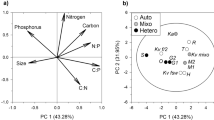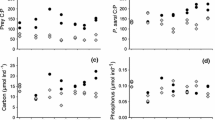Abstract
The copepod Acartia tonsa displayed nearly two-fold higher ingestion rates on faster-growing cells of the diatom Thalassiosira weissflogii compared to ingestion rates on slower-growing cells of that species at the same cell concentration. Ingestion rates on slow-growing cells were also enhanced by the addition of cell-free aliquots of algal exudate to the experimental feeding chambers. In addition, the faster-growing algal cells were selectively ingested by the copepod when the two cell types were mixed together in different proportions, indicating that physiological differences between growing cells are a critical factor in the food detection/selection process of zooplankton. Consideration of cell carbon, nitrogen, and protein composition suggests that the copepods are maximizing nitrogenous ingestion (total protein and/or nitrogen). Selectivity for cells with higher protein content results in a higher daily protein ration, even if the selection process results in a decreased rate of ingestion in mixtures of cell types.
Similar content being viewed by others
Literature cited
Ache, B. W. (1982). Chemoreception and thermoreception. In: Atwood, H. L., Sandeman, D. C. (eds.) The biology of Crustacea. Vol. 3. Neurobiology: structure and function. Academic Press, New York
Andrews, J. C. (1983). Deformation of the active space in the low Reynolds number feeding current of calanoid copepods. Can J. Fish. aquat. Sciences 40: 1293–1302
Bradford, M. P. (1976). A rapid and sensitive method for the quantitation of microgram quantities of protein utilizing the principle of protein-dye binding. Analyt. Biochem. 72: 248–254
Buskey, E. J. (1984). Swimming pattern as an indicator of the roles of copepod sensory systems in the recognition of food. Mar. Biol. 79: 165–175
Cowles, T. J. (1979). The feeding response of copepods from the Peru upwelling system: food size selection. J. mar. Res. 37: 601–622
Cowles, T. J., Strickler, J. R. (1983). Characterization of feeding activity patterns in the planktonic copepod Centropages typicus Krøyer under various food conditions. Limnol. Oceanogr. 28: 106–115
Cucci, T. L., Shumway, S. E., Newell, R. C., Selvin, R., Guillard, R. R. L., Yentsch, C. M. (1985). Flow cytometry: a new method for characterization of differential ingestion, digestion, and egestion by suspension feeders. Mar. Ecol. Prog. Ser. 24: 201–204
Derby, C. D. (1984). Molecular weight fractions of natural foods that stimulate feeding in crustaceans, with data from the lobster Homarus americanus. Mar. Behav. Physiol. 10: 273–282
Donaghay, P. L., Small, L. F. (1979). Food selection capabilities of the estuarine copepod Acartia clausi. Mar. Biol. 52: 137–146
Dortch, Q., Clayton, J R., Thoresen, S.S., Cleveland, J. S., Bressler, S. L., Ahmed, S. I. (1985). Nitrogen storage and use of biochemical indices to assess nitrogen deficiency and growth rate in natural plankton populations. J. mar. Res. 43: 437–464
Frost, B. W. (1972). Effects of the size and concentration of food particles on the feeding behavior of the marine planktonic copepod, Calanus pacificus. Limnol. Oceanogr. 17: 805–815
Frost, B. W. (1977). Feeding behavior of Calanus pacificus on mixtures of food particles. Limnol. Oceanogr. 22: 472–491
Gifford, D. J., Bohrer, R. N., Boyd, C. M. (1981). Spines on diatoms: do copepods care? Limnol. Oceanogr. 26: 1057–1061
Goldman, J. C., Dennett, M. R. (1985). Susceptibility of some marine phytoplankton species to cell breakage during filtration and post-filtration rinsing. J. exp. mar. Biol. Ecol. 86: 47–58
Guillard, R. R. L., Rhyther, J. H. (1962). Studies on marine planktonic diatoms. I. Cyclotella nana (Hustedt) and Detonula confervaceae (Cleve) Gran. Can. J. Microbiol. 8: 229–239
Hammer, K. D., Brockmann, U. H. (1983). Rhythmic release of dissolved free amino acids from partly synchronized Thalassiosira rotula under nearly natural conditions. Mar. Biol. 74: 305–312
Hamner, P., Hamner, W. M. (1977). Chemosensory tracking of scent trails by the planktonic shrimp Acetes sibogae australis. Science, N.Y. 195: 886–888
Herman, A. W. (1983). Vertical distribution patterns of copepods, chlorophyll, and production in northeastern Baffin Bay. Limnol. Oceanogr. 28: 709–719
Hitchcock, G. L. (1980). Diel variation in chlorophyll a, carbohydrate and protein content of the marine diatom Skeletonema costatum. Mar. Biol. 57: 271–278
Huntley, M. E. (1982). Yellow water in La Jolla Bay, California, July 1980. II. Suppression of zooplankton grazing. J. exp. mar. Biol. Ecol. 63: 81–91
Huntley, M., Sykes, P., Rohan, S., Marin, V. (1986). Chemicallymediated rejection of dinoflagellate prey by the copepods Calanus pacificus and Paracalanus parvus: mechanism, occurrence and significance. Mar. Ecol. Prog. Ser. 28: 105–120
Koehl, M. A. R., Strickler, J. R. (1981). Copepod feeding currents: food capture at low Reynolds number. Limnol. Oceanogr. 26: 1062–1073
Mague, T. H., Freiber, E., Hughes, D. J., Morris, I. (1980). Extracellular release of carbon by marine phythoplankton; a physiological approach. Limnol. Oceanogr. 25: 262–279
Marin, V., Huntley, M. E., Frost, B. (1986). Measuring feeding rates of pelagic herbivores: analysis of experimental design and methods. Mar. Biol. 93: 49–58
Mopper, K., Lindroth, P. (1982). Diel and variations in dissolved free amino acids and ammonium in the Baltic Sea determined by shipboard HPLC analysis. Limnol. Oceanogr. 27: 336–347
Mullin, M. M., Perry, M. J., Renger, E. H., Evans, P. M. (1975). Nutrient regeneration by oceanic zooplankton: a comparison of methods. Mar. Sci. Communs 1: 1–13
Olson, R. J., Frankel, S. L., Chisholm, S. W., Shapiro, H. M. (1983). An inexpensive flow cytometer for the analysis of fluorescence signals in phytoplankton: chlorophyll and DNA distributions. J. exp. mar. Biol. Ecol. 68: 129–144
Paffenhöfer, G.-A. (1984). Food ingestion by the marine planktonic copepod Paracalanus in relation to abundance and size distribution of food. Mar. Biol. 80: 323–333
Paffenhöfer, G.-A., Strickler, J. R., Alcaraz, M. (1982). Suspension-feeding by herbivorous calanoid copepods: a cinematographic study. Mar. Biol. 67: 193–199
Paffenhöfer, G.-A., Van-Sant, K. B. (1985). The feeding response of a marine planktonic copepod to quantity and quality of particles. Mar. Ecol. Prog. Ser. 27: 55–65
Poulet, S. A., Marsot, P. (1978). Chemosensory grazing by marine calanoid copepods (Arthropoda: Crustacea). Science, N.Y. 200: 1403–1405
Poulet, S. A., Marsot, P. (1980). Chemosensory feeding and foodgathering by omnivorous marine copepods. In: Kerfoot, W. (ed.) The evolution and ecology of zooplankton populations. University Press of New England, Hanover, N. H., p. 198–218
Poulet, S. A., Martin-Jézéquel, V. (1983). Relationships between dissolved free amino acids, chemical composition and growth of the marine diatom Chaetoceros debile. Mar. Biol. 77: 93–100
Poulet, S. A., Ouellet, G. (1982). The role of amino acids in the chemosensory swarming and feeding of marine copepods. J. Plankton Res. 4: 341–361
Price, H. J., Paffenhöfer, G.-A. (1984). Effects of feeding experience in the copepod Eucalanus pileatus: a cinematographic study. Mar. Biol. 84: 35–40
Rassoulzadegan, F., Fenaux, L., Strathmann, R. R. (1984). Effect of flavor and size on selection of food by suspension-feeding plutei. Limnol. Oceanogr. 29: 357–361
Redalje, D. G., Laws, E. A. (1983). The effects of environmental factors on growth and the chemical and biochemical composition of marine diatoms. I. Light and temperature effects. J. exp. mar. Biol. Ecol. 68: 59–79
Richman, S., Heinle, D. R., Huff, R. (1977). Grazing by adult estuarine calanoid copepods of the Chesapeake Bay. Mar. Biol. 42: 69–84
Roman, M. R., Yentsch, C. S., Gauzens, A. L., Phinney, D. A. (1986). Grazer control of the fine-scale distribution of phytoplankton in warm-core Gulf Stream rings. J. mar. Res. 44: 795–813
Ryther, J. H. (1954). Inhibitory effects of phytoplankton upon the feeding rate of Daphnia magna with reference to growth, reproduction and survival. Ecology 35: 522–533
Sharp, J. H. (1977). Excretion of organic matter by marine phytoplankton: do healthy cells do it? Oceanogr. 22: 381–399
Sokal, R. R., Rohlf, F. J. (1969). Biometry. The principles and practice of statistics in biological research. W. H. Freeman & Co., San Francisco
Starkweather, P. L., Bogdan, K. G. (1980). Detrital feeding in natural zooplankton communities: discrimination between live and dead algal foods. Hydrobiologia 73: 83–85
Steele, J. H. (1974). The structure of marine ecosystems. Harvard University Press, Cambridge, Masachusetts
Strickland, J. D. H., Parsons, T. R. (1972). A practical handbook of seawater analysis, 2nd ed. Bull. Fish. Res. Bd Can. 167: 1–310
Strickler, J. R. (1982). Calanoid copepods, feeding currents, and the role of gravity. Science, N.Y. 218: 158–160
Williamson, C. E. (1981). Foraging behavior of a freshwater copepod: frequency changes in looping behavior at high and low prey densities. Oecologia 50: 332–336
Yentsch, C. M., Horan, P. K., Muirhead, K., Dortch, Q., Haugen, E., Legendre, L., Murphy, L. S., Perry, M. J., Phinney, D. A., Pomponi, S. A., Spinrad, R. W., Wood, M., Yentsch, C. S., Zahuranec, B. J. (1983). Flow cytometry and cell sorting: a technique for analysis and sorting of aquatic particles. Limnol. Oceanogr. 28: 1275–1280
Author information
Authors and Affiliations
Additional information
Communicated by P. C. Schroeder, Pullman
Rights and permissions
About this article
Cite this article
Cowles, T.J., Olson, R.J. & Chisholm, S.W. Food selection by copepods: discrimination on the basis of food quality. Marine Biology 100, 41–49 (1988). https://doi.org/10.1007/BF00392953
Accepted:
Issue Date:
DOI: https://doi.org/10.1007/BF00392953




